Catalytic Degradation of Triphenylmethane Dyes with an Iron Porphyrin Complex as a Cytochrome P450 Model
Abstract
1. Introduction
2. Results and Discussion
2.1. Degradation of Rhodamine B
2.2. Degradation of Malachite Green (MG)
3. Materials and Methods
3.1. Materials and Instruments
3.2. Degradation of Dyes
3.2.1. Catalytic Oxidative Degradation of Rhodamine B
3.2.2. Catalytic Oxidative Degradation of Malachite Green
4. Conclusions
Author Contributions
Funding
Institutional Review Board Statement
Informed Consent Statement
Data Availability Statement
Conflicts of Interest
Sample Availability
References
- Haq, Z.U.; Tahir, K.; Aazam, E.S.; Almarhoon, Z.B.; Al-Kahtani, A.A.; Hussain, A.A.; Nazir, S.; Khan, A.U.; Subhan, A.; Rehman, K.U. Surfactants assisted SiO2-Cu@Fe2O3 nanofibers: Ultra efficient photocatalyst for photodegradation of organic compounds and transesterification of waste edible oil to biodiesel. Environ. Technol. Innov. 2021, 23, 101694. [Google Scholar] [CrossRef]
- Qi, X.; Wei, W.; Su, T.; Zhang, J.; Dong, W. Fabrication of a new polysaccharide-based adsorbent for water purification. Carbohydr. Polym. 2018, 195, 368–377. [Google Scholar] [CrossRef] [PubMed]
- Al-Kahtani, A.A. Photocatalytic Degradation of Rhodamine B Dye in Wastewater Using Gelatin/CuS/PVA Nanocomposites under Solar Light Irradiation. J. Biomater. Nanobiotechnol. 2017, 8, 66–82. [Google Scholar] [CrossRef]
- Gupta, V.K.; Suhas. Application of low-cost adsorbents for dye removal—A review. J. Environ. Manag. 2009, 90, 2313–2342. [Google Scholar] [CrossRef]
- Bilandzié, N.; Varenina, I.; Kolanovié, B.S.; Orai, D.; Zrni, S. Malachite green residues in farmed fish in Croatia. Food Control 2012, 26, 393–396. [Google Scholar] [CrossRef]
- Fallah, A.A.; Barani, A. Determination of malachite green residues in farmed rainbow trout in Iran. Food Control 2014, 40, 100–105. [Google Scholar] [CrossRef]
- Edokpayi, J.N.; Odiyo, J.O.; Durowoju, O.S. Impact of wastewater on surface water quality in developing countries: A case study of South Africa. Water Qual. 2017, 10, 10–5772. [Google Scholar]
- Vandevivere, P.C.; Bianchi, R.; Verstaete, W. Review: Treatment and Reuse of Wastewater from the Textile Wet-processing Industry: Review of Emerging Wastewater from the Textile Wet-processing Industry: Review of Emerging Technologies. Technol. J. Chem. Technol. Biotechnol. 1998, 72, 289–302. [Google Scholar]
- Galindo, C.; Jacques, P.; Kalt, A. Photochemical and Photocatalytic Degradation of an Indigoid Dye: A Case Study of Acid Blue 74 (AB74). J. Photochem. Photobiol. A 2001, 141, 47–56. [Google Scholar] [CrossRef]
- Crittenden, C.; Suri, R.P.S.; Perram, D.L.; Hand, D.W. Decontamination of Water Using Adsorption and Photocatalytic. Water Res. 1997, 31, 411–418. [Google Scholar] [CrossRef]
- Tantraviwat, D.; Nattestad, A.; Chen, J.; Inceesungvorn, B. Enhanced photoactivity and selectivity over BiOI-decorated Bi2WO6 microflower for selective oxidation of benzylamine: Role of BiOI and mechanism. J. Colloid Interface Sci. 2023, 629, 854–863. [Google Scholar] [CrossRef]
- Boochakiat, S.; Inceesungvorn, B.; Nattestad, A.; Chen, J. Bismuth–based oxide photocatalysts for selective oxidation transformations of organic compounds. ChemNanoMat 2023, 9, e202300140. [Google Scholar] [CrossRef]
- Allé, P.H.; Fanou, G.D.; Robert, D.; Adouby, K.; Drogui, P. Photocatalytic degradation of Rhodamine B dye with TiO2 immobilized on SiC foam using full factorial design. Appl. Water Sci. 2020, 10, 270. [Google Scholar] [CrossRef]
- Bibi, S.; Ahmad, A.; Anjum, M.A.R.; Haleem, A.; Siddiq, M.; Shah, S.S.; Kahtani, A.A. Photocatalytic degradation of malachite green and methylene blue over reduced graphene oxide (rGO) based metal oxides (rGO-Fe3O4/TiO2) nanocomposite under UV-visible light irradiation. J. Environ. Chem. Eng. 2021, 9, 105580. [Google Scholar] [CrossRef]
- Lu, X.; Wang, S.; Qin, J.-H. Isolating Fe-O2 intermediates in dioxygen activation by iron porphyrin complexes. Molecules 2022, 27, 4690. [Google Scholar] [CrossRef] [PubMed]
- Shiragami, T.; Matsumoto, J.; Inoue, H.; Yasuda, M. Antimony porphyrin complexes as visible-light driven photocatalyst. J. Photochem. Photobiol. C 2005, 6, 227–248. [Google Scholar] [CrossRef]
- Lee, H.; Hong, K.; Jang, W. Design and applications of molecular probes containing porphyrin derivatives. Coord. Chem. Rev. 2018, 354, 46–73. [Google Scholar] [CrossRef]
- Rayati, S.; Sheybanifard, Z.; Amini, M.M.; Aliakbari, A. Manganese porphines-NH2@SBA-15 as heterogeneous catalytic systems with homogeneous behavior: Effect of length of linker in immobilized manganese porphine catalysts in oxidation of olefins. J. Mater. Chem. A 2016, 423, 105–113. [Google Scholar] [CrossRef]
- Arellano, L.; Barrejon, M.; Gobeze, H.B.; Gomez-Escalonilla, M.J.; Fierro, J.L.G.; Dsouza, E.; Langa, F. Charge stabilizing tris(triphenylamine)-zinc porphyrin-carbon nanotube hybrids: Synthesis, characterization and excited state charge transfer studies. Nanoscale 2017, 9, 7551–7558. [Google Scholar] [CrossRef]
- Qin, J.-H.; Zhang, H.; Sun, P.; Huang, Y.-D.; Shen, Q.; Yang, X.-G.; Ma, L.-F. Ionic liquid induced highly dense assembly of porphyrin in MOF nanosheets for photodynamic therapy. Dalton. Trans. 2020, 49, 17772–17778. [Google Scholar] [CrossRef]
- Qin, J.-H.; Xu, P.; Huang, Y.D.; Xiao, L.Y.; Lu, W.; Yang, X.-G.; Ma, L.-F.; Zang, S.-Q. High loading of Mn(ii)-metalated porphyrin in a MOF for photocatalytic CO2 reduction in gas-solid conditions. Chem. Commun. 2021, 57, 8468–8471. [Google Scholar] [CrossRef] [PubMed]
- Qin, J.-H.; Xiao, Z.; Xu, P.; Li, Z.-H.; Lu, X.; Yang, X.-G.; Lu, W.; Ma, L.-F.; Li, D.-S. Anionic Porous Zn-Metalated Porphyrin Metal-Organic Framework with PtS Topology for Gas-Phase Photocatalytic CO2 Reduction. Inorg. Chem. 2022, 61, 13234–13238. [Google Scholar] [CrossRef] [PubMed]
- Dang, L.-L.; Li, T.-T.; Zhang, T.-T.; Zhao, Y.; Chen, T.; Gao, X.; Ma, L.-F.; Jin, G.-X. Highly selective synthesis and near-infrared photothermal conversion of metalla-Borromean ring and [2]catenane assemblies. Chem. Sci. 2022, 13, 5130–5140. [Google Scholar] [CrossRef] [PubMed]
- Dang, L.-L.; Zhang, T.-T.; Chen, T.; Zhao, Y.; Gao, X.; Francisco, A.; Ma, L.-F.; Jin, G.-X. Selective Synthesis and Structural Transformation of a 4-Ravel Containing Four Crossings and Featuring Cp*Rh/Ir Fragments. Angew. Chem. Int. Ed. 2023, 62, e202301516. [Google Scholar] [CrossRef]
- Li, X.; Zhao, X.; Chu, D.; Zhu, X.; Xue, B.; Chen, H.; Zhou, Z.; Li, J. Silver nanoparticle-decorated 2D Co-TCPP MOF nanosheets for synergistic photodynamic and silver ion antibacterial. Surf. Interfaces 2022, 33, 102247. [Google Scholar] [CrossRef]
- Zhou, Z.; Wang, T.; Hu, T.; Cheng, C.; Yu, S.; Li, H.; Liu, S.; Ma, L.; Zhao, M.; Liang, R.; et al. Facile synthesis of 2D Al-TCPP MOF nanosheets for efficient sonodynamic cancer therapy. Mater. Chem. Front. 2023, 7, 1684–1693. [Google Scholar] [CrossRef]
- Nam, W. High-valent iron (IV)–oxo complexes of heme and non-heme ligands in oxygenation reactions. Acc. Chem. Res. 2007, 40, 522–531. [Google Scholar] [CrossRef]
- Shah, N.S.; He, X.; Khan, J.A.; Khan, H.M.; Boccelli, D.L.; Dionysiou, D.D. Comparative studies of various iron-mediated oxidative systems for the photochemical degradation of endosulfan in aqueous solution. J. Photochem. Photobiol. A 2015, 306, 80–86. [Google Scholar] [CrossRef]
- Hodges, G.R.; Smith, J.R.L.; Oakes, J. Mechamism of oxidation of azo dyes by a sterically hindered anionic oxoiron(IV) porphyrin in aqueous solution. J. Chem. Soc. Perkin Trans. 1998, 2, 617–628. [Google Scholar] [CrossRef]
- Zucca, P.; Rescigno, A.; Pintus, M.; Rinaldi, A.C.; Sanjust, E. Degradation of textile dyes using immobilized lignin peroxidase-like metalloporphines under mild experimental conditions. Chem. Cent. J. 2012, 6, 161. [Google Scholar] [CrossRef]
- Hodges, G.R.; Smith, J.R.L.; Oakes, J. The oxidation of azo dyes by peroxy acids and tert-butyl hydroperoxide in aqueous solution catalysed by iron(III) 5,10,15,20-tetra (2,6-dichloro-3-sulfonatophenyl) porphyrin: Product studies and mechanism. J. Chem. Soc. Perkin Trans. 1999, 2, 1943–1952. [Google Scholar] [CrossRef]
- Emmert, F.L.; Thomas, J.; Hon, B.; Gengenbach, A.J. Metalloporphyrin catalyzed oxidation of methyl yellow and related azo compounds. Inorg. Chim. Acta. 2008, 361, 2243–2251. [Google Scholar] [CrossRef]
- Barros, V.P.; Assis, M.D. Iron porphyrins as biomimetical models for disperse azo dye oxidation. J. Braz. Chem. Soc. 2013, 24, 830–836. [Google Scholar] [CrossRef]
- Saha, T.K.; Frauendorf, H.; John, M.; Dechert, S.; Meyer, F. Efficient oxidative degradation of azo dyes by a water-soluble manganese porphyrin catalyst. ChemCatChem 2013, 5, 796–805. [Google Scholar] [CrossRef]
- Zhu, Z.H.; Liu, Y.; Song, C.; Hu, Y.; Feng, G.; Tang, B.Z. Porphyrin-based two-dimensional layered metal–organic framework with sono-/photocatalytic activity for water decontamination. ACS Nano 2021, 16, 1346–1357. [Google Scholar] [CrossRef]
- Shee, N.K.; Kim, H.J. Sn (IV)-Porphyrin-Based Nanostructures Featuring Pd (II)-Mediated Supramolecular Arrays and Their Photocatalytic Degradation of Acid Orange 7 Dye. Int. J. Mol. Sci. 2022, 23, 13702. [Google Scholar] [CrossRef]
- Groves, J.T.; Stern, M.K. Olefin epoxidation by manganese (IV) porphyrins: Evidence for two reaction pathways. J. Am. Chem. Soc. 1987, 109, 3812–3814. [Google Scholar] [CrossRef]
- Nam, W.; Kim, I.; Lim, M.H.; Choi, H.J.; Lee, J.S.; Jang, H.G. Isolation of an oxomanganese(V) porphyrin intermediate in the reaction of a manganese (III) porphyrin complex and H2O2 in aqueous solution. Chem. Eur. J. 2002, 8, 2067–2071. [Google Scholar] [CrossRef]
- Hicks, S.D.; Petersen, J.L.; Bougher, C.J.; Abu-Omar, M.M. Chlorite dismutation to chlorine dioxide catalyzed by a water-soluble manganese porphyrin. Angew. Chem. Int. Ed. 2011, 50, 699–702. [Google Scholar] [CrossRef]
- Groves, J.T.; Stern, M.K. Synthesis, characterization, and reactivity of oxomanganese(IV) porphyrin complexes. J. Am. Chem. Soc. 1988, 110, 8628–8638. [Google Scholar] [CrossRef]
- Latifi, R.; Tahsini, L.; Karamzadeh, B.; Safari, N.; Nam, W.; De Visser, S.P. Manganese substituted Compound I of cytochrome P450 biomimetics: A comparative reactivity study of MnV-oxo versus MnIV-oxo species. Arch. Biochem. Biophys. 2011, 507, 4–13. [Google Scholar] [CrossRef] [PubMed]
- Umile, T.P.; Groves, J.T. Catalytic generation of chlorine dioxide from chlorite using a water-soluble manganese porphyrin. Angew. Chem. Int. Ed. 2011, 50, 695–698. [Google Scholar] [CrossRef]
- Umile, T.P.; Wang, D.; Groves, J.T. Dissection of the mechanism of manganese porphyrin-catalyzed chlorine dioxide generation. Inorg. Chem. 2011, 50, 10353–10362. [Google Scholar] [CrossRef] [PubMed]
- Arunkumar, C.; Lee, Y.-M.; Lee, J.Y.; Fukuzumi, S.; Nam, W. Hydrogen-atom abstraction reactions by Manganese (V)-and Manganese (IV)-oxo porphyrin complexes in aqueous solution. Chem. Eur. J. 2009, 15, 11482–11489. [Google Scholar] [CrossRef] [PubMed]
- Rodgers, K.R.; Goff, H.M. Detection of high-valent intermediates in the chlorine (I) oxidation of (porphinato) manganese(III) complexes. J. Am. Chem. Soc. 1987, 109, 611–612. [Google Scholar] [CrossRef]
- Tokuda, J.; Ohura, R.; Iwasaki, T.; Takeuchi, Y.; Kashiwada, A.; Nango, M. Decoloration of azo dyes by hydrogen peroxide catalyzed by water-soluble manganese porphyrins. Text. Res. J. 1999, 69, 956–960. [Google Scholar] [CrossRef]
- Nakamura, J.; Oura, R.; Nango, M. Peroxide decoloration of azo dye catalyzed by manganese porphyrin derivatives in nonaqueous solvent. Text. Res. J. 2008, 78, 1080–1086. [Google Scholar] [CrossRef]
- Nango, M.; Iwasaki, T.; Takeuchi, Y.; Kurono, Y.; Tokuda, J.; Oura, R. Peroxide decoloration of azo dyes catalyzed by polyethylene glycol-linked manganese halogenated porphyrins. Langmuir 1998, 14, 3272–3278. [Google Scholar] [CrossRef]
- Saha, T.K.; Frauendorf, H.; Meyer, F. Oxidative degradation of azo dyes in aqueous solution by water-soluble Iron porphyrin catalyst. Eur. J. Inorg. Chem. 2021, 2021, 2870–2881. [Google Scholar] [CrossRef]
- Ren, D.-D.; Lu, X.; Zhou, L.-P.; Tian, H.; Wang, S.; Ma, L.-F.; Li, D.-S. Iron Porphyrin as a Cytochrome P450 Model for the Degradation of Dye. Molecules 2022, 27, 7948. [Google Scholar] [CrossRef]
- Mobeen, A.; Magdalane, C.M.; Jasmine Shahina, S.K.; Lakshmi, D.; Ramalingam, D.; Raja, A.; Madhavan, J.; Douglas, L.; Bashir, A.K.H.; Maaza, M.; et al. Investigation on antibacterial and photocatalytic degradation of Rhodamine-B dye under visible light irradiation by titanium molybdate nanoparticles prepared via microwave method. Surf. Interfaces 2021, 23, 100381. [Google Scholar] [CrossRef]
- Yan, M.; Xie, H.; Zhang, Q.; Qu, H.; Shen, J.; Kong, J. Hemin Based Biomimetic Oxidative Degradation of Acid Orange 7. J. Mater. Sci. Chem. Eng. 2016, 4, 26–34. [Google Scholar] [CrossRef]
- Dauban, P.; Sanière, L.; Tarrade, A.; Dodd, R.H. Copper-catalyzed nitrogen transfer mediated by iodosylbenzene PhI=O. J. Am. Chem. Soc. 2001, 123, 7707–7708. [Google Scholar] [CrossRef] [PubMed]

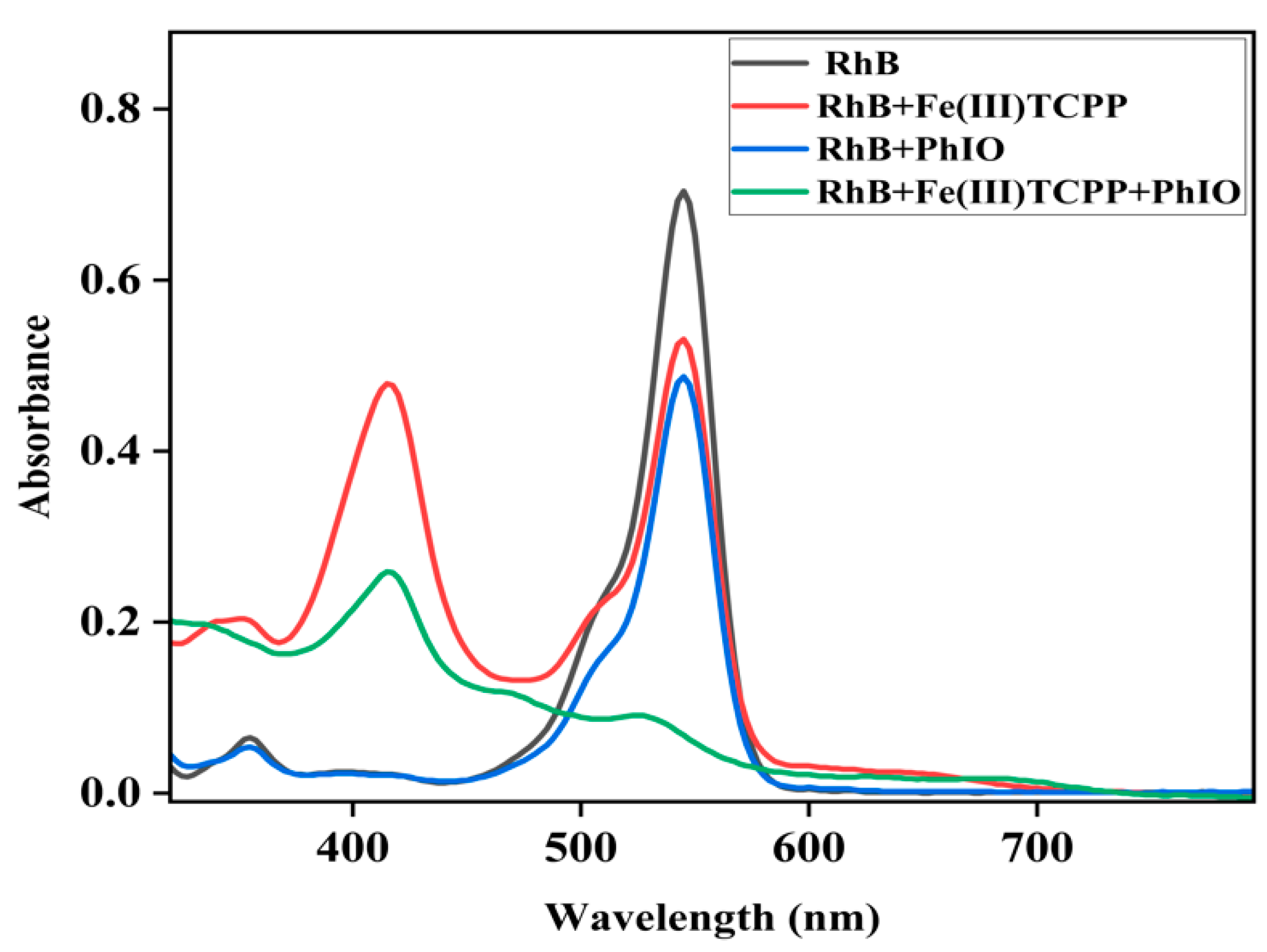


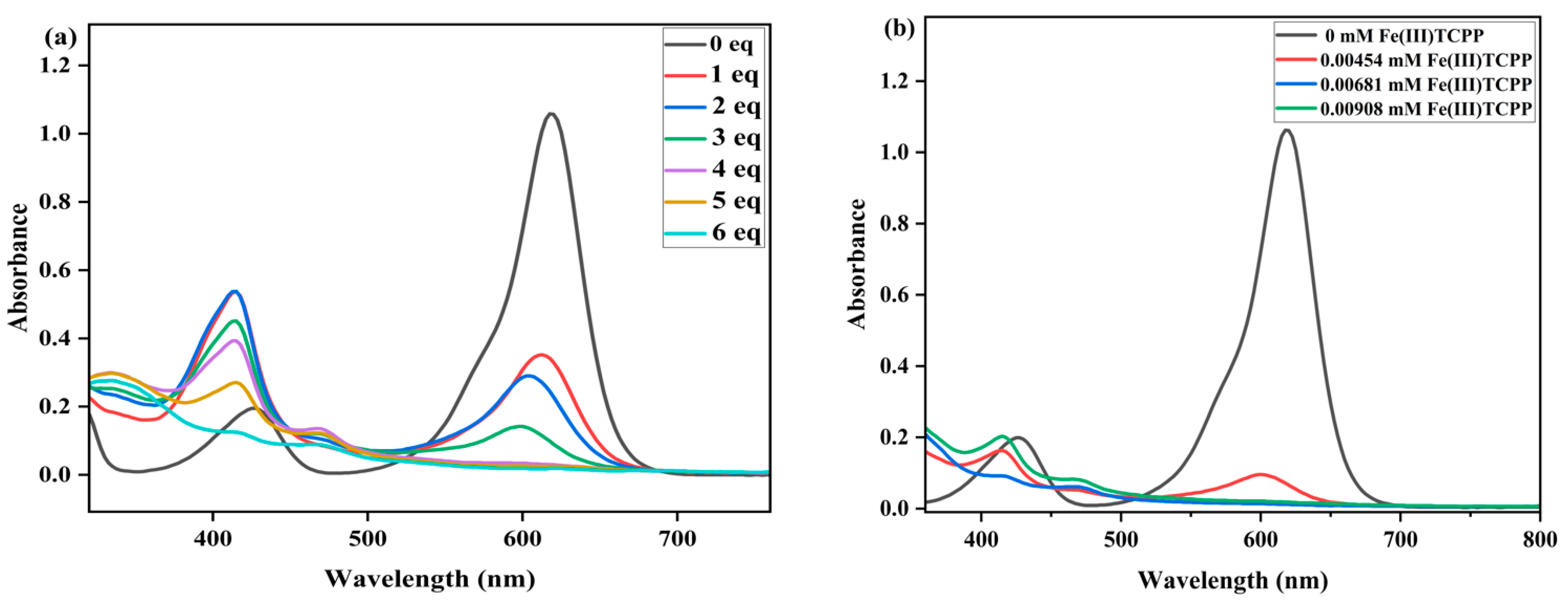
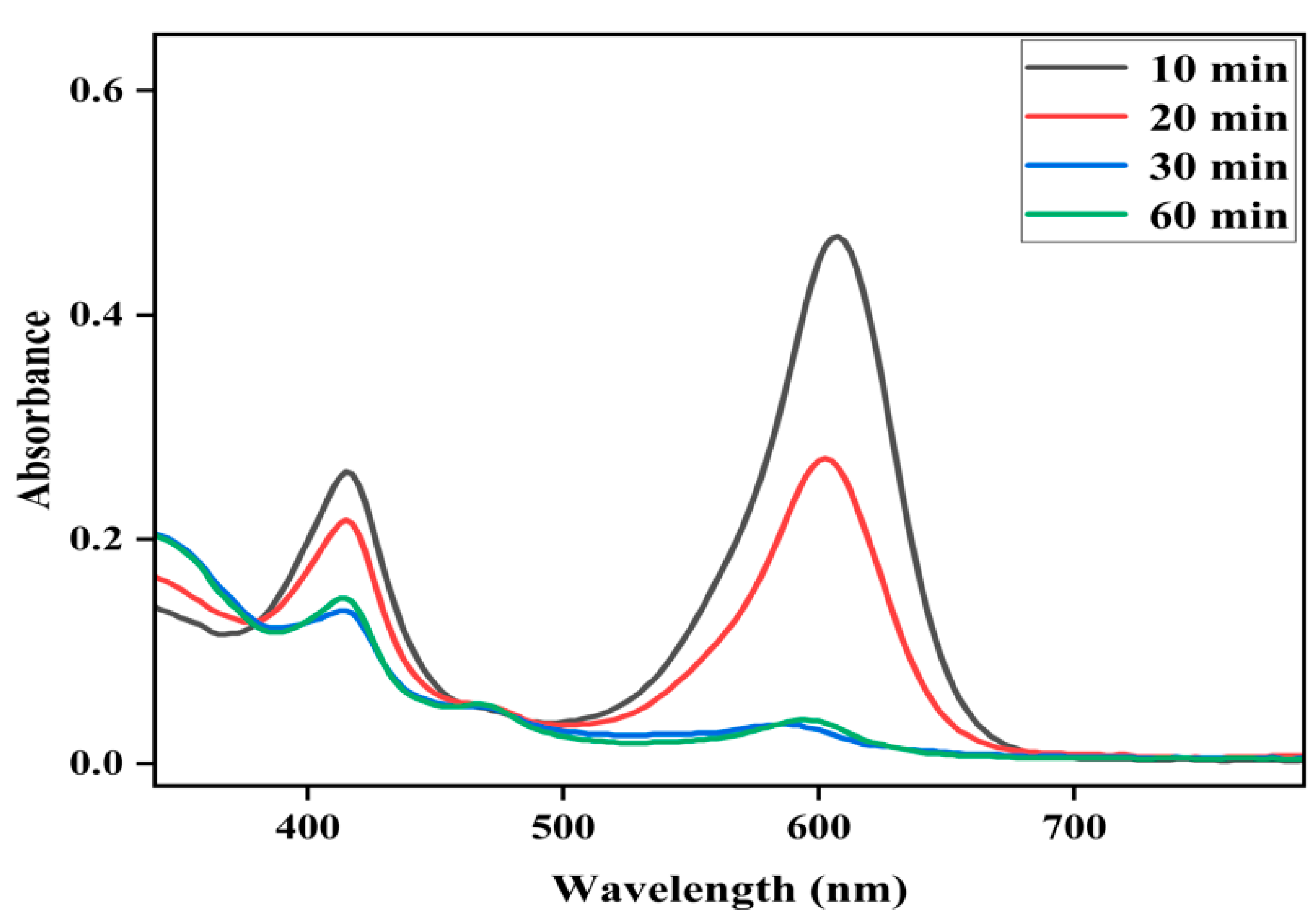
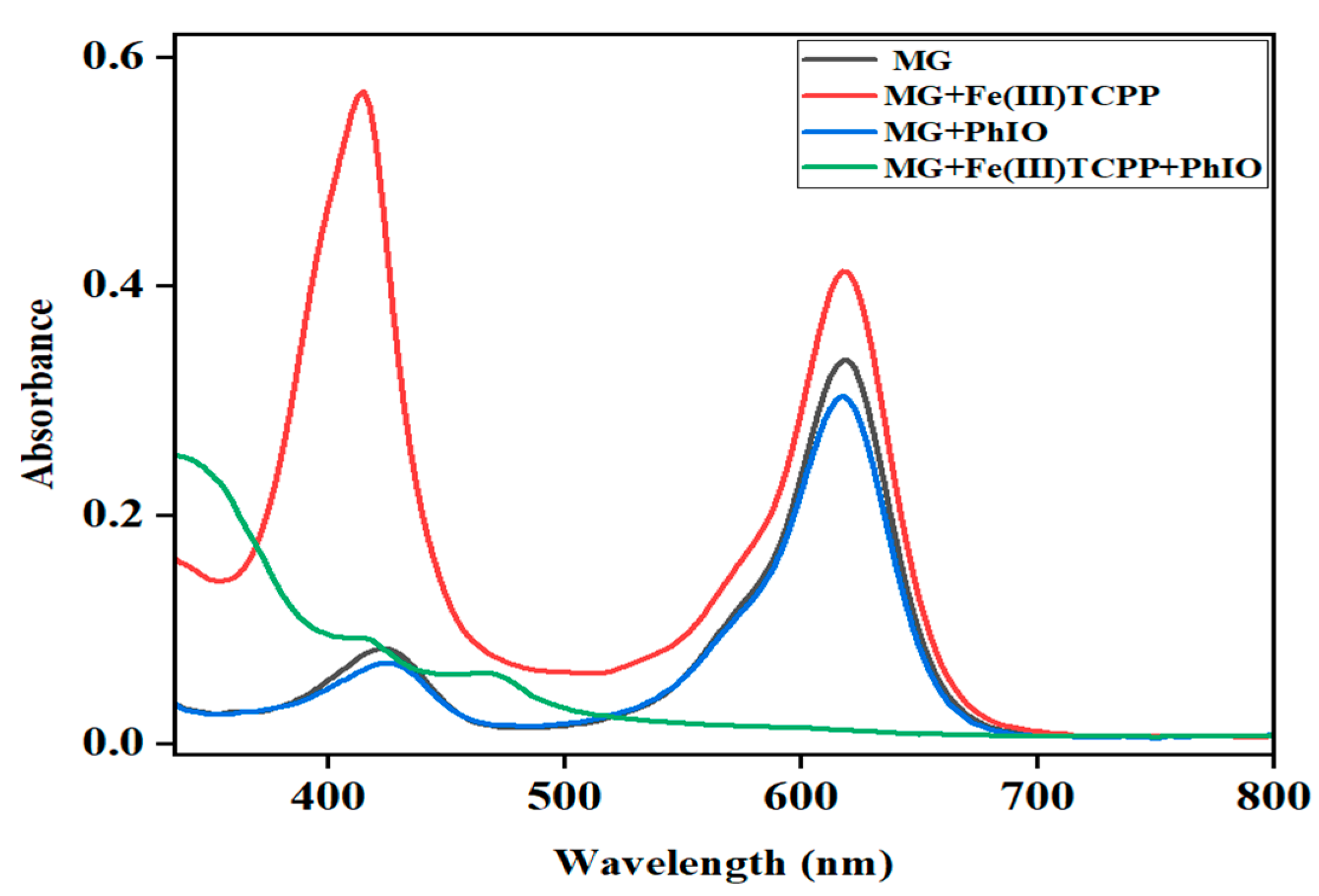
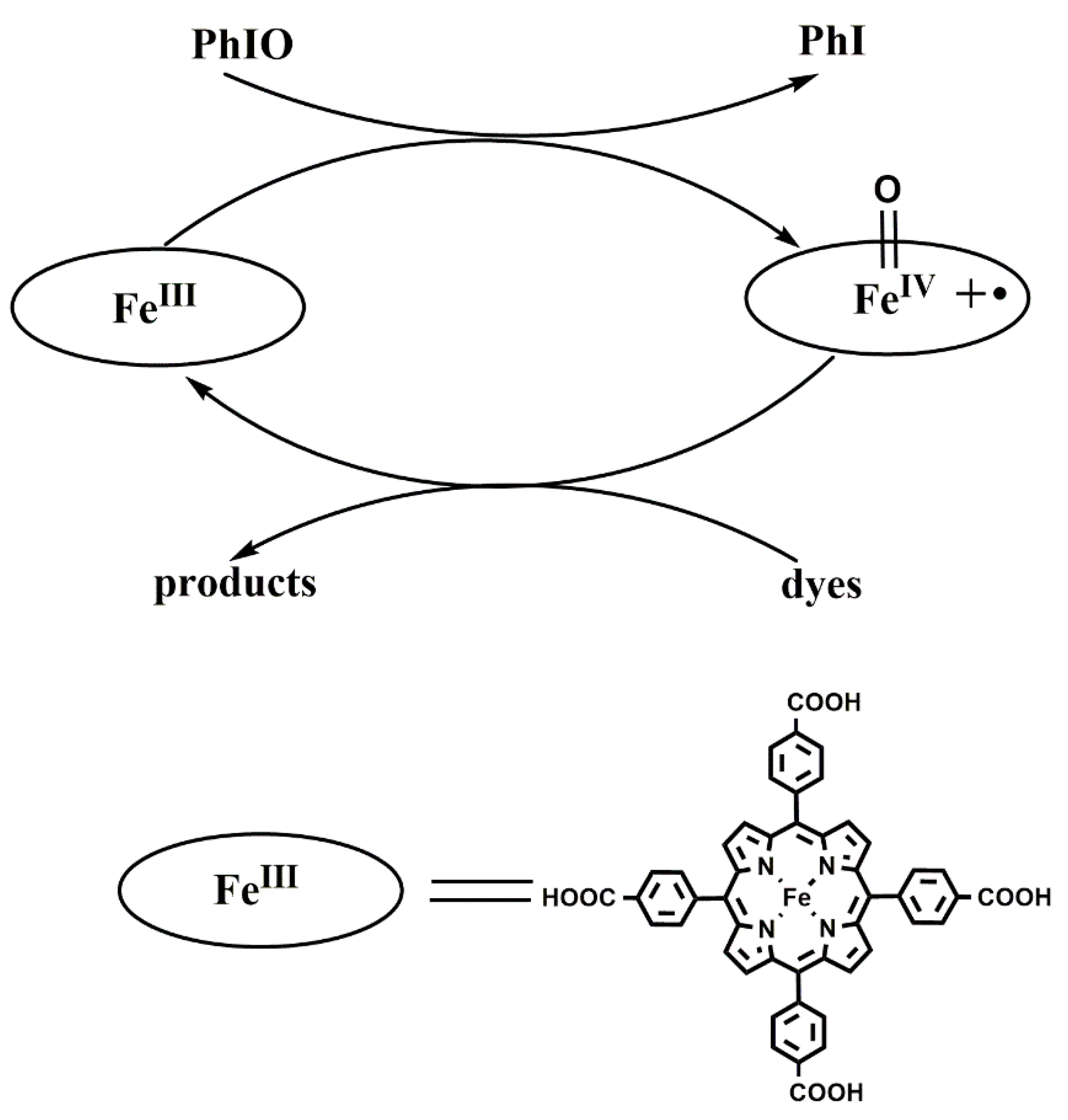
| [Fe(III)TCPP] | PhIO (eq) | Degradation Efficiency (%) |
|---|---|---|
| 0.0227 | - | 25 |
| - | 8 | 31 |
| 0.0136 | 8 | 35 |
| 0.0227 | 8 | 93 |
| 0.0272 | 8 | 93 |
| 0.0227 | 2 | 29 |
| 0.0227 | 4 | 56 |
| 0.0227 | 6 | 68 |
| 0.0227 | 8 | 93 |
| 0.0227 | 10 | 93 |
| Fe(III)TCPP | PhIO (eq) | Degradation Efficiency (%) |
|---|---|---|
| 0.00681 | - | 18 |
| - | 5 | 30 |
| 0.00454 | 5 | 93 |
| 0.00681 | 5 | 98 |
| 0.00908 | 5 | 98 |
| 0.00681 | 1 | 57 |
| 0.00681 | 2 | 70 |
| 0.00681 | 3 | 88 |
| 0.00681 | 4 | 96 |
| 0.00681 | 5 | 97 |
| 0.00681 | 6 | 98 |
Disclaimer/Publisher’s Note: The statements, opinions and data contained in all publications are solely those of the individual author(s) and contributor(s) and not of MDPI and/or the editor(s). MDPI and/or the editor(s) disclaim responsibility for any injury to people or property resulting from any ideas, methods, instructions or products referred to in the content. |
© 2023 by the authors. Licensee MDPI, Basel, Switzerland. This article is an open access article distributed under the terms and conditions of the Creative Commons Attribution (CC BY) license (https://creativecommons.org/licenses/by/4.0/).
Share and Cite
Lu, X.; Che, Q.; Niu, X.; Zhang, Y.; Chen, Y.; Han, Q.; Li, M.; Wang, S.; Lan, J. Catalytic Degradation of Triphenylmethane Dyes with an Iron Porphyrin Complex as a Cytochrome P450 Model. Molecules 2023, 28, 5401. https://doi.org/10.3390/molecules28145401
Lu X, Che Q, Niu X, Zhang Y, Chen Y, Han Q, Li M, Wang S, Lan J. Catalytic Degradation of Triphenylmethane Dyes with an Iron Porphyrin Complex as a Cytochrome P450 Model. Molecules. 2023; 28(14):5401. https://doi.org/10.3390/molecules28145401
Chicago/Turabian StyleLu, Xiaoyan, Qiman Che, Xinkai Niu, Yilin Zhang, Yu’e Chen, Qing Han, Miaoqing Li, Shuang Wang, and Jihong Lan. 2023. "Catalytic Degradation of Triphenylmethane Dyes with an Iron Porphyrin Complex as a Cytochrome P450 Model" Molecules 28, no. 14: 5401. https://doi.org/10.3390/molecules28145401
APA StyleLu, X., Che, Q., Niu, X., Zhang, Y., Chen, Y., Han, Q., Li, M., Wang, S., & Lan, J. (2023). Catalytic Degradation of Triphenylmethane Dyes with an Iron Porphyrin Complex as a Cytochrome P450 Model. Molecules, 28(14), 5401. https://doi.org/10.3390/molecules28145401





